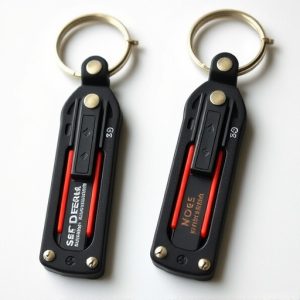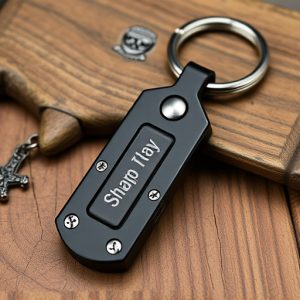Keychain Safety Device Legal Requirements: Global Regulations & Manufacturing Standards
Choosing the best keychain weapon striking points involves balancing legality and effectiveness. Und…….
Choosing the best keychain weapon striking points involves balancing legality and effectiveness. Understanding your state's regulations is vital, as rules vary widely. Globally, laws dictate acceptable self-defense options, emphasizing non-lethal force. Manufacturers must adhere to strict standards for consumer safety and product quality, ensuring legal compliance through testing and certifications. Rigorous evaluations and responsible use are key to leveraging keychain self-defense devices effectively while staying within legal boundaries.
In today’s world, personal safety is paramount. One innovative solution gaining traction is the keychain safety device—a compact self-defense tool designed for easy carrying. But navigating legal requirements can be a daunting task. This comprehensive guide explores the intricate web of regulations surrounding keychain weapons, delving into key definitions, state-by-state laws, federal guidelines, and international standards. We’ll also dissect manufacturing standards, labeling protocols, and consumer safety measures, including testing, certifications, and recall processes. Understanding these striking points is crucial for both manufacturers and users seeking the best protection.
- Understanding Legal Definitions: What Constitutes a Keychain Weapon?
- Key States and Their Unique Regulations on Personal Defense Devices
- Federal Guidelines and International Laws: A Global Perspective
- Exploring Specific Requirements for Keychain Safety Device Manufacturing and Labeling
- Ensuring Consumer Safety: Testing, Certifications, and Recalls
Understanding Legal Definitions: What Constitutes a Keychain Weapon?
When discussing keychain safety devices and their legal requirements, it’s crucial to understand how laws define what constitutes a keychain weapon. In many jurisdictions, a keychain weapon is categorized based on its ability to cause harm and its design as a striking or cutting tool. This includes keychains with built-in blades, spikes, or other sharp edges designed for self-defense or offensive purposes.
The “best” keychain weapon striking points aren’t just about effectiveness but also legality. Keychain devices should be designed with safety in mind, ensuring they cannot cause excessive harm or injury. Legal definitions often consider factors like blade length, material, and the overall design’s capability to inflict serious damage. Therefore, when choosing a keychain safety device, it’s essential to stay within legal boundaries and opt for products that prioritize both functionality and user safety.
Key States and Their Unique Regulations on Personal Defense Devices
Each state in the US has its own set of regulations regarding personal defense devices, including keychain weapons. When considering the best keychain weapon striking points or any self-defense tool, it’s crucial to understand your state’s specific laws. Some states have broad regulations that govern all types of personal defense devices, while others may have unique restrictions based on factors like size, shape, and the type of force they can deploy.
For instance, California has some of the strictest laws regarding self-defense tools, often requiring permits for certain devices. In contrast, states like Texas have more relaxed regulations, allowing a wider range of personal defense items, including some keychain weapons. It’s essential to research your state’s legal requirements to ensure you’re complying with local laws and using these devices responsibly.
Federal Guidelines and International Laws: A Global Perspective
In terms of global perspective, the legal landscape surrounding keychain safety devices, particularly those designed as self-defense tools, is a complex web influenced by both federal guidelines and international laws. Each country has its own set of regulations that dictate what constitutes an acceptable self-defense mechanism and the permissible levels of force it can employ. For instance, while some nations allow for more robust defense options, including keychains with sharp edges or stun features, others have stringent restrictions on the type and intensity of force civilians can use for self-protection.
When considering the best keychain weapon striking points from a global legal standpoint, it’s crucial to understand that what might be deemed reasonable in one country could be illegal in another. International laws often emphasize proportionality and necessity, advocating for the use of non-lethal force unless absolutely necessary. Therefore, keychains designed as self-defense tools must adhere to these principles, ensuring they offer effective protection without exceeding legal boundaries, especially when considering international travel or movement.
Exploring Specific Requirements for Keychain Safety Device Manufacturing and Labeling
In the manufacturing process of keychain safety devices, adhering to stringent legal requirements is paramount. These regulations are designed to ensure consumer safety and product quality. One key aspect involves identifying and prioritizing the best keychain weapon striking points – strategic locations that maximize effectiveness in self-defense scenarios. Manufacturers must thoroughly test and certify these features, ensuring they meet industry standards for impact force and precision.
Additionally, clear and concise labeling is a legal mandate. Product labels should vividly describe the device’s functionality, including its capabilities as a self-defense tool. This information empowers consumers to make informed choices, understanding the potential benefits and limitations of the keychain safety device. Proper labeling also includes instructions for safe handling and storage, emphasizing responsible use.
Ensuring Consumer Safety: Testing, Certifications, and Recalls
Ensuring consumer safety is paramount when it comes to keychain safety devices, especially those designed for self-defense purposes. Testing and certifications play a vital role in guaranteeing that these tools meet specific performance standards. Reputable manufacturers often conduct rigorous tests to assess factors like durability, sharp edge retention, and the overall effectiveness of their products as best keychain weapon striking points. These tests can include drop resilience, penetration depth, and impact force simulations.
In addition, industry-recognized certifications from reputable bodies ensure that a keychain safety device meets legal requirements and offers reliable protection. Consumer recalls are another critical aspect of maintaining safety, as they allow manufacturers to withdraw products from the market if any issues or defects are identified, ensuring that potentially hazardous items don’t reach consumers. Regularly staying informed about recalls is essential for responsible users who want to leverage their keychain defense tools safely and effectively.
When considering a keychain safety device, it’s crucial to navigate a web of legal requirements that vary greatly by region. From state-specific definitions of what constitutes a keychain weapon to international standards for manufacturing and labeling, understanding these regulations is key to ensuring consumer safety. By adhering to the best practices outlined in this article, including knowing the top striking points for effectiveness, you can make an informed decision while staying within legal boundaries. Remember that compliance with testing, certifications, and recall procedures is essential to protect users and maintain a responsible market for personal defense devices.


